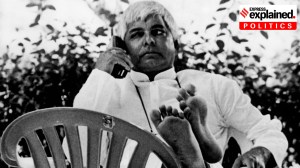Shotgun fires only blanks
So, even when Sinha has little in common with the British minister, it seemed like an auspicious beginning. Especially when the star-turned-...

• Shatrughan Sinha (December 1, 2001, on not being inducted in the Cabinet)
‘‘I am not the Health Minister for Delhi that I should stay here all the time. I am the Health Minister for the whole of India.’’
• Shatrughan Sinha (November 22, 2002, on charges of being constantly absent from the ministry and Parliament.)
It was not long back when the ‘Bihari Babu’ of Bollywood was trying all stunts — from supporting the Opposition demand for George Fernandes’s ouster from the Union Cabinet to inviting Sonia Gandhi for the staging of his play — to embarrass the BJP leadership.
The frustration about being constantly ignored for inclusion in the Cabinet had the Shotgun firing indiscriminately. He changed his track only when it became clear that his party had decided to award him a Cabinet berth, finally. The problem was, it was the role of upkeeping the nation’s health that Sinha was offered as a pacifier.
Almost everyone concerned with healthcare hoped against hope that Sinha’s astrologers were not shooting in the dark when they chose July 3 as the day for him to join the Health Ministry. Legendary British Health Minister Aneurin Bevan had kicked off the landmark National Health Service (NHS) on July 5, 1948, paving the way for similar efforts elsewhere.
|
HIV positive
cases in india |
So, even when Sinha has little in common with the British minister, it seemed like an auspicious beginning. Especially when the star-turned-actor pledged to give it his best shot. ‘‘Sewa karne ka ek mauka mila hai. Main apni poori taakat laga ke kaam karoonga (It’s a chance to serve the people. I will work to the best of my ability),’’ he announced before the crowd that packed the Minister’s chambers that day. Five months down the line, these words somehow don’t pack the same punch.
The Transparency International has just declared the health sector as one of the ten most corrupt sectors in the country. The latest Human Development Report published by the UNDP presented a gloomy picture of India’s healthcare index. India ranks 124th in the world on the Human Development Index — a statistic that is compiled on the basis of life expectancy, literacy and GDP. Even compared with the other developing countries such as Sri Lanka, India stands much lower. And as we cross the mid-point of the current government’s term in office, all the targets set in the much publicised National Health Policy, 2000, seem quite hard to achieve.
Here are some of the major targets set in the Health Policy 2002:
• Eradication of Polio by 2005.
• Reduce mortality by 50 per cent on by curbing TB, Malaria and other vector and water-borne diseases.
• Establish a system of surveillance via the National Health Accounts and Health Statistics.
• Reduce infant mortality rate from 30/1,000 to 100/1,00,000.
• Increase utilisation of public health facilities from the current level of less than 20 per cent to more than 75 per cent.
|
Polio fact sheet
|
While the Minister has taken it upon himself to tour the length and breadth of the country and the world, inaugurating health melas and attending conferences, the target-oriented approach of the Health Policy is the best indicator of how much his travels are helping the cause for which they are undertaken.
The Pulse Polio programme was working well till last year, but this year has been disastrous. Today, India is contributing to 68 per cent of the world’s Polio cases. ‘‘If things don’t improve, we will have Polio spreading across the country once again,’’ says a Health Ministry official.
Even in terms of reducing mortality by TB, Malaria and other water-borne diseases, we haven’t reached anywhere. Just a month back, over 53 kids died in UP because of an ailment initially diagnosed as Japanese Encephalitis. The Ministry didn’t bat an eyelid till the media created a furore. With seeming reluctance, a team of experts from National Institute of Communicable Diseases (NICD) was despatched to Saharanpur — incidentally, the UP Chief Minister Mayawati’s constituency — where most of the cases were reported from. The much-touted ‘interim report’ revealed that there was no epidemic in UP. The experts termed the main cause of death as ‘viral encephalitis’. Everyone, including the minister, is happy with the report even when it clearly fails to identify the virus or name the specific treatment for the virus.
|
Cancer mortality cases
(in percentage) |
‘‘What good is NICD if it only tells us ‘viral encephalitis’ killed the kids. What was the virus? Was it Japanese encephalitis, meningitis or cerebral malaria? Why haven’t they named the vector?’’ asks a senior faculty member in the All India Institute of Medical Sciences (AIIMS).
TB kills as many as 1,000 people a day. The National TB Control Programme (NTCP) was launched in 1962 but it has not made any significant epidemiological impact on problem of TB. The programme was reviewed by an Expert Committee in 1992. Based on the findings and recommendations of the review, the Government of India evolved the Revised National TB Control Programme (RNTCP) based on Directly Observed Treatment Short Course (DOTS) strategy with the objective of curing at least 85 percent of new sputum positive patients and detecting at least 70 percent of such patients.
The RNTCP now covers about 460 million people. It is envisaged to cover 800 million population by 2004 and the entire country by 2005. During 2001, under RNTCP 4.7 lakh TB patients were initiated on treatment. Yet a 1,000 deaths a day!
Non-communicable diseases such as cancer are doubling their burden on the country’s already meagre health budget. Cancer is now estimated to be one of the ten leading causes of deaths in India despite the National Cancer Control Programme that was started in 1975-76.
So far as the fourth major target of reducing infant mortality rate is concerned, the figures show we have made absolutely no improvement even in terms of improving the routine immunisation cover. In 1996, the immunisation cover was 56.3 percent and there is no improvement over that in the last six years. TO make matters worse, in some states, the number of children who have not even received part-immunisation has gone up.
In the minister’s home state of Bihar where only 11 percent of the children are fully vaccinated as against the national average of 56.3 percent. One in every 14 children die in Bihar within the first year of their lives and the under-five mortality is over 105 per 1,000 children. The low immunisation coverage in itself is an indicator of the reach of health services that the Health Policy document proposes to increase by over 75 per cent.
The three-tier healthcare infrastructure is supposed to comprise a sub-centre for every 5,000 people, a primary healthcare centre for every 30,000 population and community health centres for every 80,000 to 1.2 lakh people. The current availability is just 1.37 lakh subcentres, 23,266 primary health centres and 2,962 community health centres in the whole of India. Not only is the doctor/population ratio low at 48 doctors per one lakh population but according the Health Ministry estimates, there is a huge difference in the availability of doctors in the urban areas (approximately 73.6 percent) and rural areas where the availability is as low as 26.4 percent.
The minister, meanwhile, is busy trying to win accolades for making ‘paradigm shifts’ in the existing policy. Sinha announced this ‘paradigm shift’ in the form of an Action Plan at a public function on November 30, a day before the World AIDS Day. It was told that this was an absolutely new Action Plan that, for the first time, would reveal its HIV status to the blood donors. But a scan of the new idea’s precursor, the National Blood Policy, 2002, announced by the then Health Minister C.P. Thakur in April, 2002, shows there’s little new. Asks a senior ministry official: ‘‘What can you say when the whole effort is towards self-projection and not making the programme really work?’’
While the Ministry works on its well-charted out programmes regardless of who presides over it, it is a fact that Sinha’s presence hasn’t even had the token effect that a minister can personally produce. There are at least two national programmes that were supposed to have been launched by the ministry this year — one on Rabies, and the other on senior citizens — but nothing has moved so far.
To give Sinha his due, it is true that after Sinha arrived on the scene, more people are talking about health than ever before. It is also true that he has generated a lot of international goodwill by his travels abroad. Jeffrey Sacchs, Advisor to UN Secretary General Kofi Annan, pointed out after his meeting with Sinha in New York recently: ‘‘India has a very dynamic Health Minister.’’
But the problem is that like his public image, Sinha is intent on doing something spectacular, that would give him instantaneous accolades without sullying his hands in the routine job of improving the public healthcare infrastructure.
‘‘Why would anyone be happy in just implementing old policies and programmes? It doesn’t make you popular. So one has to try and do something novel, something that hasn’t been done before. In that process, nothing ever gets done,’’ says a former Health Minister. Anyone listening?



- 01
- 02
- 03
- 04
- 05




























